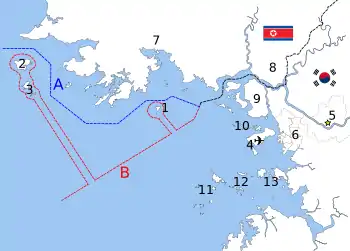| Daecheongdo | |
.jpg.webp) | |
| Korean name | |
|---|---|
| Hangul | |
| Hanja | |
| Revised Romanization | Daecheongdo |
| McCune–Reischauer | Taech‘ŏngdo |

A: United Nations Command-created Northern Limit Line, 1953[2]
B: North Korea-declared "Inter-Korean MDL", 1999[3] The locations of specific islands are reflected in the configuration of each maritime boundary, including
Daecheongdo (Korean: 대청도; lit. big blue island; pronounced [tɛtɕʰɔŋdo]) or Daecheong Island is a 12.63 km2 (4.88 sq mi), 7 km (4.3 mi) long and 6.3 km (3.9 mi) wide island in Ongjin County, Incheon, South Korea, near the Northern Limit Line.[4]
The 1953 Korean Armistice Agreement which ended the Korean War specified that the five islands including Daecheong Island would remain under U.N. and South Korea control. This agreement was signed by both DPRK and United Nations Command.[5] Since then, it has served as a maritime demarcation between North and South Korea in the Yellow Sea (also called "West Sea").
The island is 19 km (12 mi) from the coast of South Hwanghae Province in North Korea.[6]
History
It is theorized that Daecheongdo was first inhabited during the Neolithic Age (9500–4500 BC). There are definite signs of habitation from the Goryeo Dynasty (918–1392), during which time the island was used as a place of exile for criminals. The Chinese Emperor Toghon Temür (1320–1370) was exiled there by the Mongol Yuan Dynasty for conspiring in a plot arranged by his stepmother. Legend says he arrived at the island with a court and 100 relatives, then built a palace. The island was generally uninhabited until 1793, when King Jeongjo, of the Joseon Dynasty (1392–1897), imported farmers to cultivate the land. During the Japanese occupation of Korea between 1910 and 1945, there were as many as 10,000 people living there and a large port.
Today, the island has approximately 1,500 people who sustain a living from tourism and fishing.[7]
Economy
Fishing is popular on the island. Until the late 1980s, skate fishing was a growing industry.[6]
Environment
The island is at the northernmost natural range of the Camellia japonica.[8]
Neighboring islands
Two islands nearby are Baengnyeong Island and the much smaller Socheong Island.
2009 battle
On 10 November 2009, the waters near the island were the scene of a skirmish between the South Korean and North Korean navies. A patrol boat from North Korea was seriously damaged while the navy of South Korea sustained no casualties.[9]
References
- ↑ Ryoo, Moo Bong. (2009). "The Korean Armistice and the Islands," p. 13 or p. 21. Strategy research project at the U.S. Army War College; retrieved 26 Nov 2010.
- ↑ "Factbox: What is the Korean Northern Limit Line?" Reuters (UK). November 23, 2010; retrieved 26 Nov 2010.
- ↑ Van Dyke, Jon et al. "The North/South Korea Boundary Dispute in the Yellow (West) Sea," Marine Policy 27 (2003), 143-158; note that "Inter-Korean MDL" is cited because it comes from an academic source Archived March 9, 2012, at the Wayback Machine and the writers were particular enough to include in quotes as presented. The broader point is that the maritime demarcation line here is NOT a formal extension of the Military Demarcation Line; compare "NLL—Controversial Sea Border Between S.Korea, DPRK, " People's Daily (PRC), November 21, 2002; retrieved 22 Dec 2010
- ↑ Yŏnʼguwŏn, Hanʼguk Kukpang (1999). "Defense white paper". Ministry of National Defense, Republic of Korea.
{{cite journal}}: Cite journal requires|journal=(help) - ↑ Armistice Agreement, paragraph 13(b). "Text of the Korean War Armistice Agreement". FindLaw. 1953-07-27. Archived from the original on 2008-07-06. Retrieved 2010-11-25.
- 1 2 Daecheongdo Island. Visit Incheon.
- ↑ "Destinations by Region : VisitKorea Destinations by Region Daecheongdo Island (대청도) | Official Korea Tourism Organization".
- ↑ "Daecheong-do". Galbijim.
- ↑ Foster, Peter (11 November 2009). "North and South Korean ships exchange fire". The Daily Telegraph.
External links
- Official website
- Official website (in Korean)